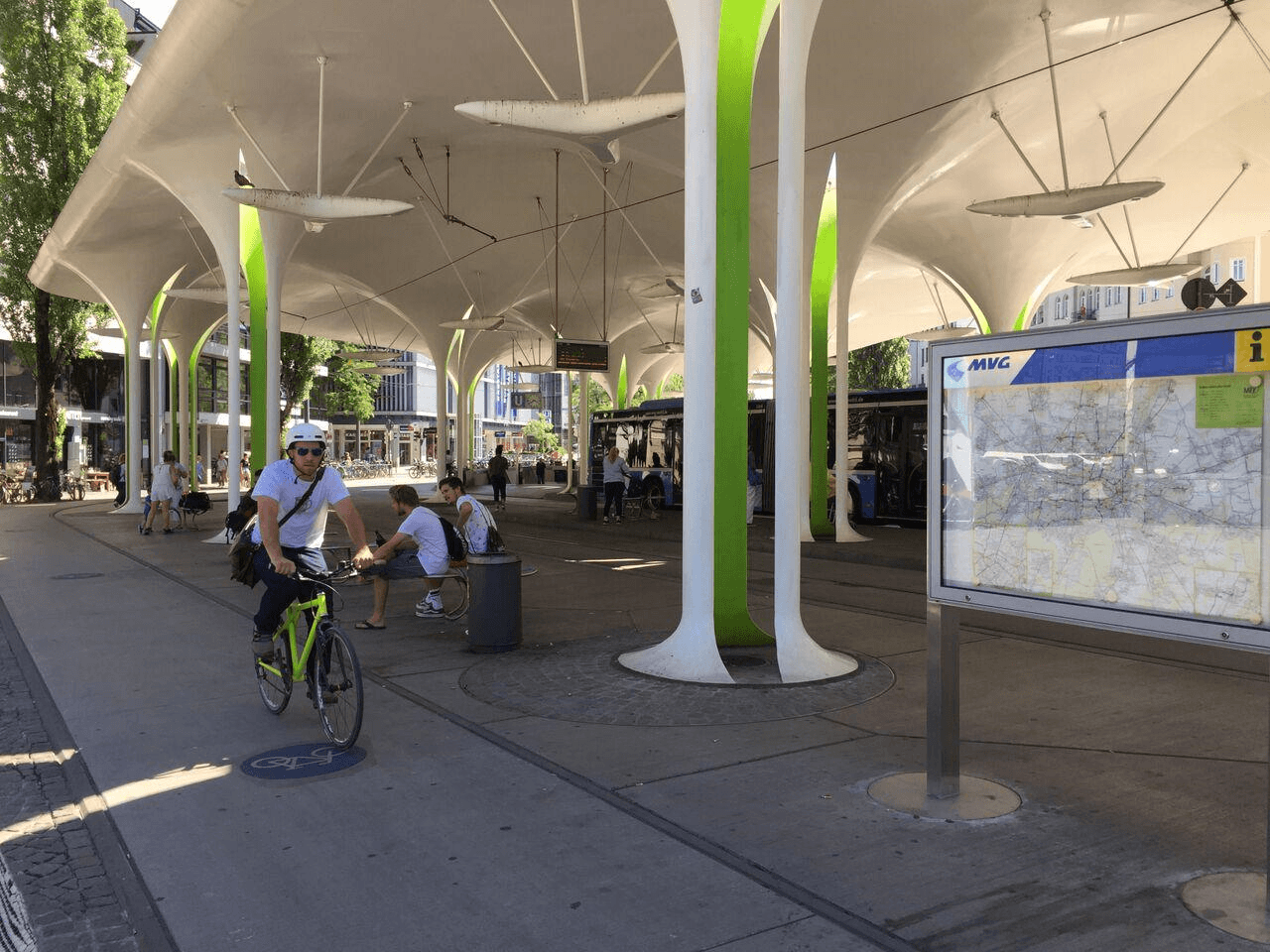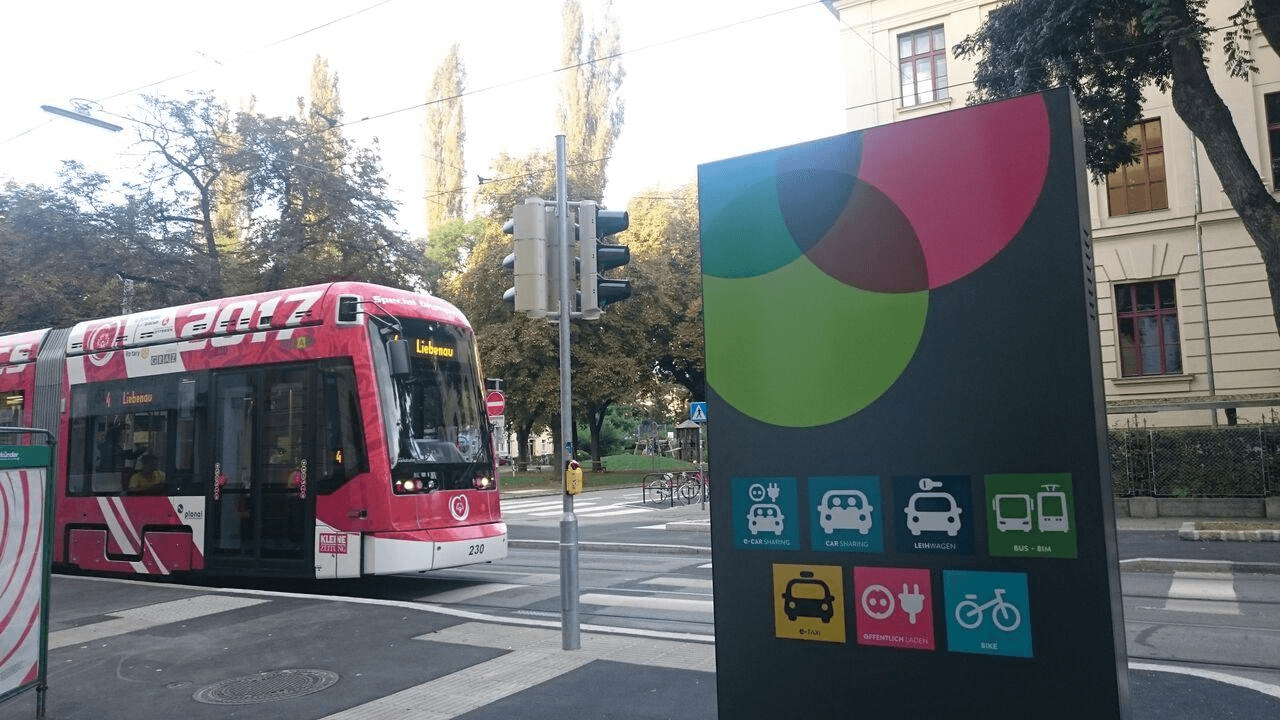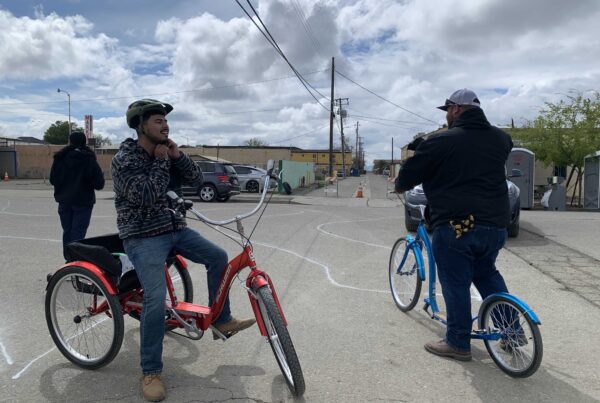The Shared-Use Mobility Center (SUMC) and the Federal Highway Administration (FHWA) recently released an international benchmarking study for implementing shared mobility services. The team studied programs and projects from across Europe, where many of the “new” mobility practices in the U.S.—like bikeshare, mobility hubs, and Mobility as a Service (MaaS)—have existed for decades.
As the center-point of over a year of research, the team performed a study tour of three European cities that have established and regulated innovative shared mobility projects: Munich, Germany; Paris, France; and Brussels, Belgium. The group met with transportation and mobility experts from transit agencies, mayors’ offices, departments of transportation, universities, shared mobility operators, and regulatory bodies as well as EU representatives to observe and discuss effective strategies for application across the board.
From public-private partnerships to visionary leadership, policy breakthroughs to fare payment innovations, the study is rich with case studies that support findings in four principal areas.
1. Boundary-defying public-private partnerships and contracting methods
As an international confederation made up of some two dozen nations, the EU has a more layered regulatory environment, which requires clear objectives and collaboration in development, investment and in creating contracts. In addition, this allows services to be scaled efficiently beyond organizational and geographical boundaries.
The report details three types of “boundary-defying arrangements”:
Outcome-Oriented Contracting Models
The City of Milan provided operational incentives for shared mobility services that meet certain city-defined requirements for serving public goals. These requirements, such as providing accessible vehicles, equitable geographic distribution, regular data reporting, are clearly defined, as are the benefits providers derive from providing services beyond the bare minimum, such as preferential parking, access to low-emission zones, and discounted licensing fees for cleaner vehicles. Providers can gain further fee savings by providing user incentives to travel at non-peak times, documenting vehicle shedding, and leaving vehicles in specified, harder to serve locations.
Governance Models
Paris’ public transportation company, Régie Autonome des Transports Parisiens (RATP), is an example of a state-owned agency that has learned to successfully operate in the private sector. The French agency created a holding company for subsidiary interests and, among other acquisitions, took a stake in the private transit operator TransDev, which now provides transportation planning, engineering, and service delivery around the world, including operating bus and rail services in a number of US cities.
Funding Models
Boundary-defying partnerships lend themselves to a variety of flexible revenue streams that go beyond the farebox and public subsidy. The report explores three models:
- RATP Dev (the Parisian transit agency’s in-house venture fund described above),
- Deutsche Bahn Digital Ventures (a technology-focused investment arm of Germany’s largest railway company) and
- Wiener Stadtwerke (which not only owns and operates public transit in Vienna and across Austria, but also develops and manages the digital infrastructure for MaaS delivery in a number of European cities).
2. Proactive planning and design for shared infrastructure and electrification.
The foundation of a mobility system is, literally, the infrastructure it operates on. Bike lanes, on-street carshare parking spaces, and EV charging hubs are vital for those services to function─ and they (mostly) cannot be constructed overnight. Western Europe, and Germany in particular, is further ahead than almost anybody in the world on the concentration of multiple modes of transportation infrastructure at key points called “integrated mobility hubs.”
Mobility hubs physically integrate modes by co-locating carsharing, bikesharing, and other shared-mobility services, at public transit stops. Mobility hubs can also feature bike parking, dedicated curb space for taxis and for-hire vehicles, and–crucially–wayfinding and placemaking elements that make them into much more than glorified bus shelters. The study tour visited mobility hubs at a variety of scales and met with experts from the city’s technical university who are researching mobility hubs’ impacts on travel behavior. Munich continues to push the envelope on what a mobility hub can be, piloting the inclusion of cargo bikes, delivery lockers, and building the hubs into the heart of new residential developments like the Domagkpark, as pictured below.

The Mobility Station at Münchner Freiheit
3. Forward-thinking transit agency leadership with a vision for shared mobility connectivity.
Many North Americans may picture European cities as quaint and cobblestoned echoes of the past, with narrow streets that have long been filled with multimodal transport: bicycles, trams, buses, rail and pedestrians. The truth is, plenty of car-dominated, low-density spaces exist in Europe, especially in areas with extensive post-WWII development. The difference is that Europe has made a choice to invest in sustainable mobility solutions led by innovative transit agency leadership. The fact that more people choose multimodal transit options overseas is the result of deliberate policy choices and investments by cities and national governments. Many public entities in Europe have been actively looking for ways to integrate modes and streamline the experience for riders and agencies, particularly with innovative fare payment solutions.
The MVG more App in Munich integrates payments from multiple transit providers and provides real-time travel information and route-planning functionality.
The Brussels public transit agency’s MOBIB card includes bikesharing, carsharing, taxis, parking and fare payment on several other Belgian railways.
The Navigo Pass in Paris is a contactless card system and smartphone app that integrates payment for all transit, buses, and select railways, as well as careshare and bikeshare.
4. Development of “whole community” approaches to reduce personal vehicle travel and to create and support shared mobility.
Initiatives in the European cities studied tended to be comprehensive and far-reaching. “Whole communities” often encompassed countries and beyond. While American transportation policies are predominantly local or regional in focus, a widespread vision is something that can be achieved. Despite our differing landscapes and patterns of urban development, US citizens share a desire for mobility choices that are sustainable, affordable, and broadly accessible. By sharing best practices and case studies, collaborating on policy initiatives and focusing on cooperation at multiple levels, we can create a comprehensive system of funding, research, and planning dedicated to sustainable mobility.
Read the report on the FHWA site OR download the pdf here.
To learn about the latest developments in Shared Mobility, and collaborate on innovative solutions, join us at the 2019 National Shared Mobility Summit, March 5-7 in Chicago. Learn more at summit.sharedusemobilitycenter.org.



